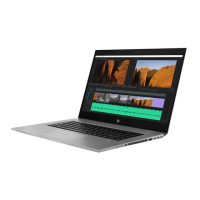Identify the issue
1. Understand the issue
It is important to understand the issue that occurred, including related symptoms. It helps to understand the
basic computer boot-up sequence as well as the failure itself. The boot-up sequence and associated failures
are described below.
Boot up sequence
The computer performs several steps after you press the power button or restart the computer.
It is important to understand where in the boot-up sequence the symptoms occur. The following table lists
the phases of the boot-up sequence and explains the symptoms that may occur in each phase. For example, a
blue screen error (BSOD) often occurs during the performance phase.
Table 6-2 Boot-up sequence
Item Procedure
Power-on After power button is pressed, the computer boots after all internal power rails (i.e., 5V, 3.3V) are stable.
Conrm that power lights are on fan is spinning.
Common issues: all lights are o; troubleshooting lights are on; does not boot; video is absent.
POST (UEFI/BIOS) Power-On Self-Test (POST) veries that hardware components (processor, hard drive, memory, etc.) are
functional. When POST is complete, the HP logo displays briey and then disappears.
If there are errors, the computer may exhibit blinking lights and POST error messages
Common issues: lights blink, error message appears, hangs.
Performance
(operating system)
System boots to operating system, and Windows logo screen appears.
Common issues: hangs (lock up/freezes), blue screen, video distorted, driver conict, slow performance,
display issue (dead pixel), I/O issue (no speaker sound), wireless/audio unavailable, noise.
See Analyze the issue on page 82 table below for detailed troubleshooting information).
Failure classication
Failure classication is a breakdown of dierent types of failures and symptoms that could occur during the
boot-up sequence. Table 3 and table 4 represent the failure classication for common notebook failures.
Table 3 categorizes failures by the boot-up sequence.
1. Power-on: Common issues are No Power, Recycle/Reboot, etc.
2. POST: Common issues are No Boot (have power), Light Flash or Diagnostics Error.
3. Performance: Common issues are Intermittent Loss of Power, Blue Screen, Hang, etc. In many cases,
issues may be identied and associated with a particular hardware (i.e., display, storage).
Table 4 categorizes failures by hardware.
4. Display
5. I/O devices (Input/Output)
6. Storage
7. Mechanical
General troubleshooting steps 79

